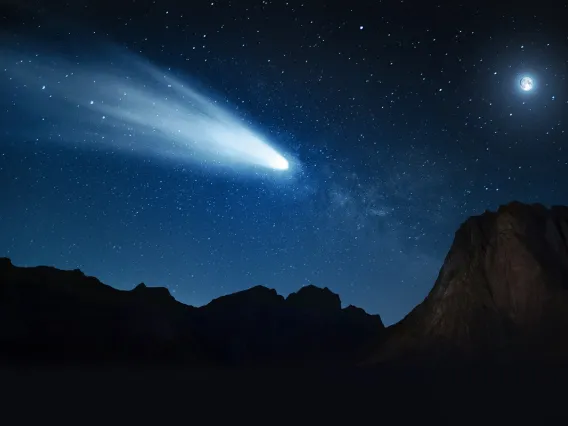
Beyond Jupiter, Researchers Discovered a 'Cradle of Comets'
Researchers have discovered a region just beyond Jupiter that acts as a "comet gateway," funneling icy bodies from deep space into the inner solar system, where they can become regular visitors of Earth's neighborhood.
Beyond Jupiter, Researchers Discovered a 'Cradle of Comets'
×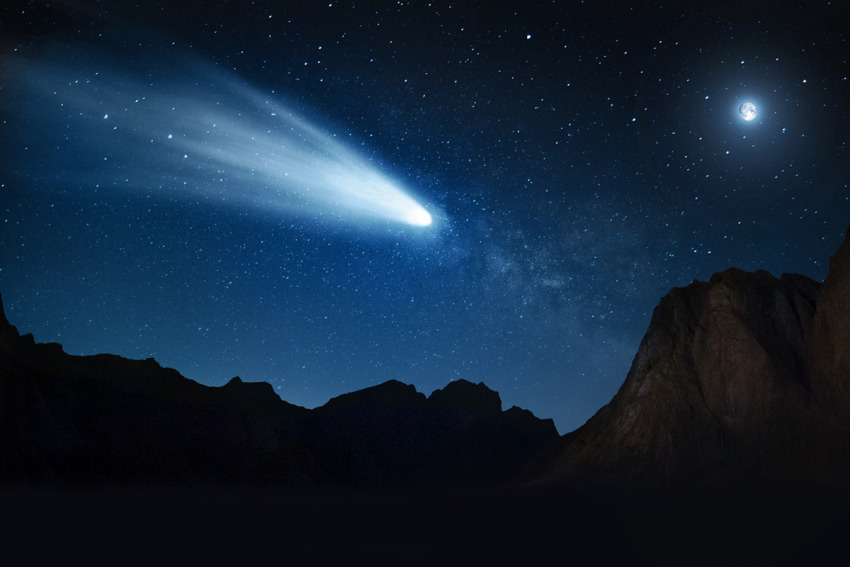
By Daniel Stolte, University Communications - October 22, 2019
Comets are known to have a temper. As they swoop in from the outer edges of our solar system, these icy bodies begin spewing gas and dust as they venture closer to the sun. Their luminous outbursts can result in spectacular sights that grace the night sky for days, weeks or even months.
But comets aren't born that way, and their pathway from their original formation location toward the inner solar system has been debated for a long time. Comets are of great interest to planetary scientists because they are likely to be the most pristine remnants of material left over from the birth of our solar system.
In a study published in The Astrophysical Journal Letters, a team of researchers including Kathryn Volk and Walter Harris at the University of Arizona Lunar and Planetary Laboratory report the discovery of an orbital region just beyond Jupiter that acts as a "comet gateway." This pathway funnels icy bodies called centaurs from the region of the giant planets – Jupiter, Saturn, Uranus and Neptune – into the inner solar system, where they can become regular visitors of Earth's neighborhood, cosmically speaking.
Roughly shaped like an imaginary donut encircling the area, the gateway was uncovered as part of a simulation of centaurs, small icy bodies traveling on chaotic orbits between Jupiter and Neptune.
Centaurs: Icy Rogues on Haphazard Trails
Centaurs are believed to originate in the Kuiper belt, a region populated by icy objects beyond Neptune and extending out to about 50 Astronomical Units, or 50 times the average distance between the sun and the Earth. Close encounters with Neptune nudge some of them onto inward trajectories, and they become centaurs, which act as the source population of the roughly 1,000 short-period comets that zip around the inner solar system. These comets, also known as Jupiter-family comets, or JFCs, include comets visited by spacecraft missions such as Tempel 1 (Deep Impact), Wild 2 (Stardust) and 67P/Churyumov-Gerasimenko (Rosetta).
"The chaotic nature of their orbits obscures the exact pathways these centaurs follow on their way to becoming JFCs," said Volk, a co-author on the paper and an associate staff scientist who studies Kuiper belt objects, planetary dynamics and planets outside our solar system. "This makes it difficult to figure out where exactly they came from and where they might go in the future."
Jostled by the gravitational fields of several nearby giant planets – Jupiter, Saturn and Neptune – centaurs don’t tend to stick around, making for a high-turnover neighborhood, Harris said.
"They rattle around for a few million years, perhaps a few tens of millions of years, but none of them were there even close to the time when the solar system formed," he said.
"We know of 300 centaurs that we can see through telescopes, but that's only the tip of an iceberg of an estimated 10 million such objects," Harris added.
"Most centaurs we know of weren't discovered until CCD's became available, plus you need the help of a computer to search for these objects," Volk said. "But there is a large bias in observations because the small objects simply aren't bright enough to be detected."
Where Comets Go to Die
Every pass around the sun inflicts more wear and tear on a comet until it eventually breaks apart, has a close encounter with a planet that ejects it from the inner solar system, or its volatiles – mostly gas and water – are depleted.
"Often, much of the dust remains and coats the surface, so the comet doesn't heat up much anymore and it goes dormant," Harris said.
By some mechanism, a steady supply of "baby comets" must replace those that have run their course, "but until now, we didn't know where they were coming from," he added.
To better understand how centaurs become JFCs, the research team focused on creating computer simulations that could reproduce the orbit of 29P/Schwassmann-Wachmann 1, or SW1, a centaur discovered in 1927 and thought to be about 40 miles across.
SW1 has long puzzled astronomers with its high activity and frequent explosive outbursts despite the fact that is too far from the sun for water ice to melt. Both its orbit and activity put SW1 in an evolutionary middle ground between the other centaurs and the JFCs, and the original goal of the investigation was to explore whether SW1’s current circumstances were consistent with the orbital progression of the other centaurs.
To accomplish this, the team modeled the evolution of bodies from beyond Neptune’s orbit, through the giant planet’s region and inside Jupiter’s orbit.
"The results of our simulation included several findings that fundamentally alter our understanding of comet evolution," Harris said. "Of the new centaurs tracked by the simulation, more than one in five were found to enter an orbit similar to that of SW1 at some point in their evolution."
In other words, even though SW1 appears to be the only large centaur of the handful of objects currently known to occupy the "cradle of comets," it is not the outlier it was thought to be, but rather ordinary for a centaur, according to Harris.
In addition to the commonplace nature of SW1’s orbit, the simulations led to an even more surprising discovery.
"Centaurs passing through this region are the source of more than two-thirds of all Jupiter-family comets," Harris said, "making this the primary gateway through which these comets are produced."
"Historically, our assumption has been that the region around Jupiter is fairly empty, cleaned out by the giant planet's gravity, but our results teach us that there is a region that is constantly being fed," Volk says.
This constant source of new objects may help explain the surprising rate of icy body impacts with Jupiter, such as the famous Shoemaker-Levy 9 event in 1994.
A Comet Worthy of Worship
Based on estimates and calculations of the number and size of objects entering, inhabiting and leaving the gateway region, the study predicted it should sustain an average population of about 1,000 Jupiter-family objects, not too far off the 500 that astronomers have found so far.
The results also showed that the gateway region triggers a rapid transition: once a centaur has entered it, it is very likely to become a JFC within a few thousand years, a blink of an eye in solar system timeframes.
The calculations suggest that an object of SW1's size should enter the region every 50,000 years, making it likely that SW1 is the largest centaur to begin this transition in all of recorded human history, Harris and Volk suggest. In fact, SW1 could be on its way to becoming a "super comet" within a few thousand years.
Comparable in size and activity to comet Hale-Bopp, one of the brightest comets of the 20th century, SW1 has a 70% chance of becoming what could potentially amount to the most spectacular comet humankind has ever seen, the authors suggest.
"Our descendants could be seeing a comet 10 to 100 times more active than the famous Halley comet," Harris said, "except SW1 would be returning every six to 10 years instead of every 75."
"If there had been a comet this bright in the last 10,000 years we would know about it," Volk said.
"We take this as strong evidence that a similar event has not happened at least since then," Harris said, "because ancient civilizations would not only have recorded the comet, they may have worshiped it!"
The study was co-authored by Gal Sarid and Maria Womack, both of the Florida Space Institute and the University of Central Florida; Jordan Steckloff of the Planetary Science Institute and the University of Texas at Austin; and Laura Woodney of California State University.
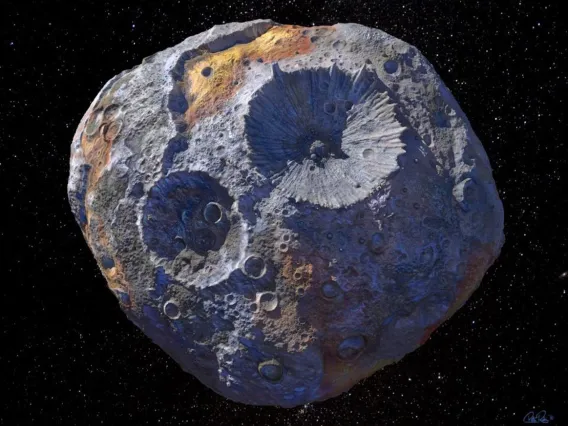
Iron Magma Could Explain Psyche’s Density Puzzle
Volcanism has always intrigued humanity. Less than 50 years ago, scientists discovered cryovolcanism – ice volcanoes on other worlds. Now, researchers may have identified volcanoes of molten metal.
Iron Magma Could Explain Psyche’s Density Puzzle
×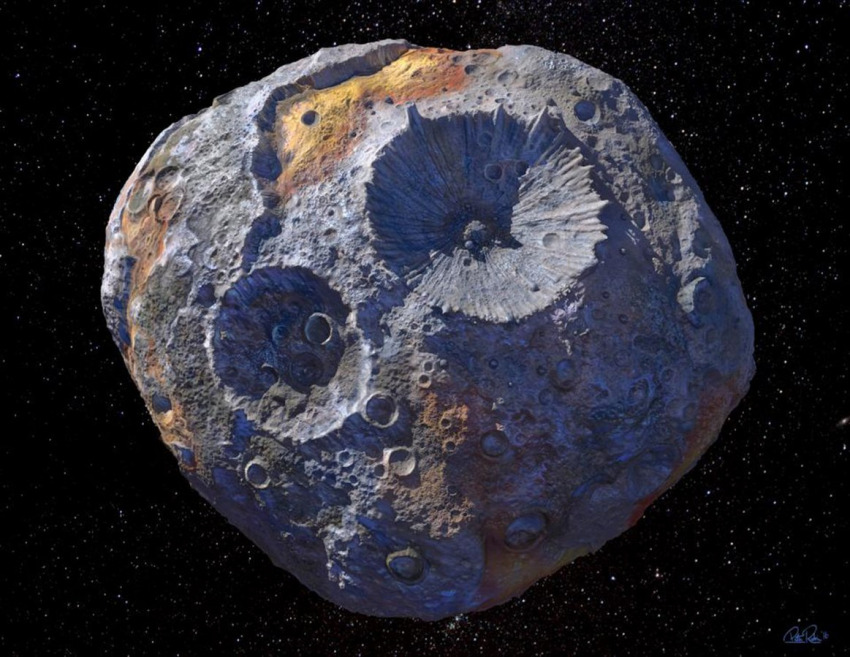
By Mikayla Mace, University Communications, & Emil Venere, Purdue University - September 23, 2019
The metallic asteroid Psyche has mystified scientists because it is less dense than it should be. Now, a new theory by researchers including scientists at the University of Arizona, could explain Psyche’s low density and metallic surface.
Psyche, the largest known metallic asteroid in the solar system, is located in the asteroid belt between Mars and Jupiter. Psyche appears to be composed largely of iron and nickel, rather than rocky rubble, like most asteroids, yet its density is estimated to be only about half that of an iron meteorite.
Metal-rich asteroids are thought to have formed when primordial planetesimals collided, stripping away much of the outer material and leaving behind the inner metallic cores, which then cooled and solidified from the outside in. During this cooling process, an alloy of residual melted pockets of iron, nickel and lighter elements like sulfur, might have flowed to the surface through fluid-filled cracks called dikes, coating a topmost, rocky layer.
“We refer to these processes collectively as ‘ferrovolcanism,’” said Brandon Johnson, an associate professor of earth and atmospheric sciences at Purdue University.
“This is a very new idea as of 2019. It’s a kind of volcanism where the magma is liquid metal instead of liquid rock,” said Michael Sori, an associate staff scientist at the UA Lunar and Planetary Laboratory.
The theory is detailed in a paper that was recently published in Nature Astronomy. The paper was co-authored by Johnson, Sori and Alexander Evans, an assistant professor of earth, environmental and planetary sciences at Brown University.
“The first half of the paper is really theoretical. We show that the process is viable,” Sori said. “Then the second half, we give two examples of things we think it can explain. One is meteorites and the other is Psyche.”
Meteorites called pallasites are thought to be a mixture of core and mantle material, possibly blended together by ferrovolcanism. The pockets of liquid metal mixed with sulfur are less dense than surrounding solid material, producing an “excess pressure” and possibly causing the propagation of dikes and allowing ferrovolcanism to occur.
The researchers determined how far these dikes would have to propagate to make volcanism possible.
“Our calculations suggest that ferrovolcanic eruptions may be possible for small, metal-rich bodies, especially for sulfur-rich melts and bodies with mantles thinner than about 35 kilometers or bodies where the mantle has been locally thinned by large impact craters,” Johnson said.
An upcoming NASA space mission to Psyche, planned for 2022, will help scientists test this theory. The ferrovolcanic eruptions might explain Psyche’s low density, which exists despite radar and other scientific evidence of a metallic surface composition. The researchers theorize that the asteroid might consist of two layers, where a metal core is surrounded by a lower density mantle of rocky material.
“Ferrovolcanism may have transported core material to the surface, causing the radar detections of metal,” Johnson said.
The research is ongoing, with future work harnessing more sophisticated modeling to study how ferrovolcanism might occur and possibly probing Psyche’s evolution.
No spacecraft has yet to visit a metallic asteroid, and the concept of ferrovolcanism is based on mathematical models. Sori’s role was applying these models to the asteroid Psyche.
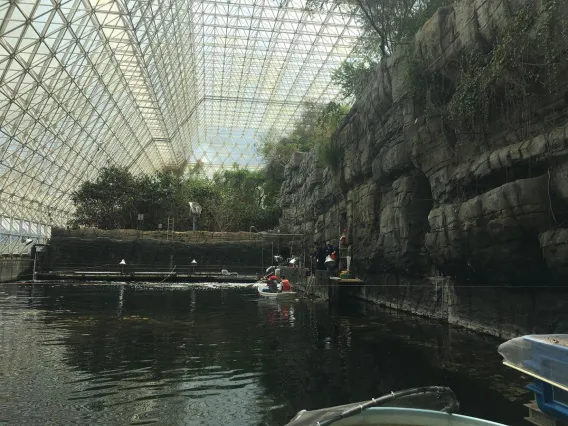
Today’s Students are Tomorrow’s Space Explorers
Ten students from Japan and Arizona gathered for the first official Space Camp at Biosphere 2, where they designed Biosphere 3 to sustain life on Mars.
Today’s Students are Tomorrow’s Space Explorers
×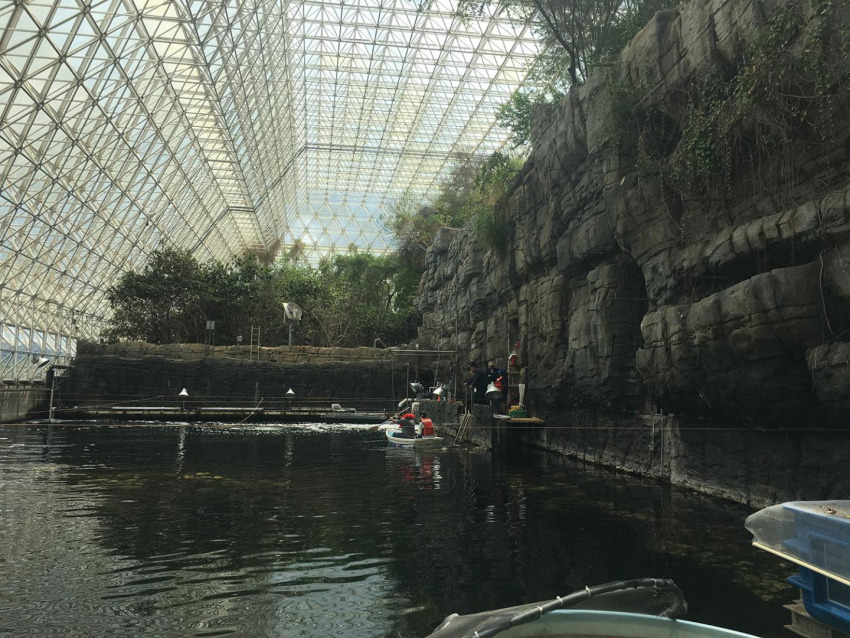
By Mikayla Mace, University Communications - August 14, 2019
From the depths of the ocean’s trenches to the most tenuous heights of the atmosphere and everything in between, Biosphere 1 encompasses all life on Earth. The University of Arizona’s Biosphere 2 is the world’s largest earth science laboratory, housing seven model ecosystems dedicated to the research of global scientific issues. Today’s students, and the next generation of interplanetary explorers, have imagined what Biosphere 3 will become on the surface of the Red Planet.
Ten undergraduate students – five from Kyoto University in Japan and five from colleges across Arizona, including one from the UA, gathered for the first official Space Camp at Biosphere 2, held Aug. 5-10. The summer camp was jointly organized and run by researchers from Kyoto and the UA.
At Biosphere 2, the students participated in hands-on research in the facility’s diverse ecosystems including the rainforest, ocean and desert biomes. They also attended lectures by faculty from both universities and three NASA and JAXA astronauts – Richard Linnehan, Kimiya Yui and Takao Doi – about their training and experiences in space.
The activities generated discussion about how to translate lessons learned from the Biosphere 2 closed system for human life support on Mars.
“We worked together to plan Biosphere 3,” said Daniel McConville, a UA sophomore majoring in materials science and engineering.
McConville plans to someday become an astronaut and use the education and experiences he gained at the UA and Space Camp to pursue a career in space development. He hopes to be part of teams that construct bases on the moon and Mars.
“This is a unique opportunity for us to partner with researchers from Japan who have experience on the International Space Station, leverage the expertise the UA has with planetary exploration and conduct research in Biosphere 2,” said John Adams, deputy director of Biosphere 2. “Many researchers have the strong belief that an extended stay in space needs to be balanced between bioregegenerative life support systems and traditional mechanical devices, not just one or the other. The Biosphere is a great place to have those conversations and discuss lessons learned here with the students.”
Biosphere 3
Students were broken up into five groups of two students from both countries. The first team analyzed the geology of Mars to understand resource availability and select a construction site; The second team focused on developing food production techniques to last 50 years for 10 astronauts; The third, which included McConville, designed the human habitat.
The fourth group developed ways to monitor and mitigate harmful radiation. The fifth analyzed student mental and physical health while inhabiting a closed environment for a long period of time. They measured stress levels and recorded vital signs using Fitbits, among other observations.
After a long week of exploring Biosphere 2, the students presented their plans for Biosphere 3. Many were based on lessons learned from the first group of Biospherians that emerged from their sealed excursion more than 25 years ago.
“Biosphere 2 has been running ecosystems for nearly 30 years, which has never been done, Doi said. “Biosphere 2 is not perfect, but we can learn a lot.”
Radiation will be one of the biggest hurdles to space exploration.
“We don’t know if we can even achieve migration to Mars. Even traveling is dangerous and nearly fatal. It’s an expensive problem to overcome,” said Yosuke Yamashiki, a professor at Kyoto University.
As an exercise, the students calculated the radiation dosage in different parts of the biosphere under different conditions. Yamashiki suggested building Biosphere 3 with the ocean on top; A meter of water can be protective against harmful rays.
Another major issue facing the original Biospherians was figuring out how to sustain nutritionally sufficient diets. To avoid some of the same pitfalls, the students decided to incorporate aquaponics, a system of growing crops in water containing fish to cycle nutrients.
“It’s 90% more efficient in terms of water usage and you get three times better crop yield,” McConville said.
Diana Ramirez, an Arizona State University senior majoring in microbiology, drew inspiration from the desert: “Mesquite bean pods have protein and cactus can be eaten,” she said. Desert plants could be used as water-efficient crops.
Future explorers will also have to balance carbon dioxide and oxygen levels in a closed ecosystem, which was a struggle for the original crew sealed within the glass and steel.
“We can’t replicate life-sustaining systems if we don’t first fully understand earth systems,” said Katie Morgan, manager of marine systems at Biosphere 2. “I also believe that the tech we develop for Mars should also help us on Earth.”
Another problem will be energy consumption: “Biosphere 2 also uses a lot of energy,” McConville said. “Solar might be the best way to power Biosphere 3, but there are limitations like weaker sunlight. We also considered nuclear power.”
Dust will also be a major issue for those living on Mars. Martian soil can potentially be carcinogenic and damage electronics in Biosphere 3. The students researched a suit-docking station concept, so the suits (and dust) never have to enter the facility.
McConville said another consideration is the cost of launching building materials to the Red Planet. The students decided they’d send robots ahead of humans to 3D print as many structural components as possible. Explorers from Earth would then follow with additional materials to make the structure airtight. The facility should be lit with lightweight, energy efficient LED bulbs as well as fiber optics to direct in sunlight when windows might be scarce, McConville said. Additionally, air and water recycling systems were inspired by the International Space Station’s closed system.
“A balance between biological and mechanical systems to create a truly self-sustaining environment has not been done yet,” Adams said. “Space Camp has provided an overview of these topics. It’s the initial insight as they further their studies.”
Give Them Space
For many of the students, the best part was interacting with real NASA and JAXA astronauts. While McConville and many others wanted to be astronauts since childhood, Ramirez didn’t dream of venturing into space. She has since changed her mind.
“The astronauts said I should go up there and that my skills will be needed. Now, all I want is to go to space,” Ramirez said.
Yusaku Miyashita, a Kyoto student, has wanted to be an astronaut since he was a kid. He is studying to be a medical doctor and believes space medicine is a necessary field of the future.
“The people who will explore Mars by the 2030s are now students,” said Takao Doi, a Kyoto University professor and former astronaut. He traveled to space in 1997 and again in 2008, spending a total of 32 days in space.
In recent years, he’s decided to promote human space exploration, he said. He came up with the idea for the space camp in 2017.
“As a university, we were already thinking about future Mars missions. We have the land but not the facility. It’s too expensive. We decided: Don’t build, collaborate instead,” said Yamashiki.
Future space camps
Ramirez enjoyed working with international students with a diversity of majors. She believes one of the most important aspects of the camp is the interdisciplinary work.
“We need a mix of sciences in space,” she said. “We all referred to each other with questions during discussions and had the dynamics of a cohesive crew.”
Nearly 50 students from Arizona and over 40 students from Japan applied to the program, according to Michelle Coe, Arizona/NASA Space Grant Consortium manager who coordinated the student selection process. The selected Arizona students come from a diverse pool of majors, demographics and colleges, she said.
Space missions will have to be an international effort, Doi said. In the future, he hopes to incorporate more students from more countries.
Kyoto University ran Space Camp for the past two years in Japan, and this year, they partnered with Biosphere 2 to facilitate and expand the program. Doi and his team will receive additional funding from the Ministry of Education, Culture, Sports, Science and Technology of Japan and continue Space Camp at Biosphere 2 in 2020 and 2021, he said.
“A lot of applicants had outstanding letters of recommendation and high grade point averages, but what made the selected students stand out,” Coe said, “was that each of them talked about getting to work with a different community of STEM (science, technology, engineering and math) scholars, which I thought was important, and also talked about their visions for the future.”
The UA Department of Hydrology and Atmospheric Sciences, UA Lunar and Planetary Laboratory, Biosphere 2 and the Kyoto University Unit for Synergetic Studies for Space, as well as the Graduate School of Advanced Integrated Studies in Human Survivability of Kyoto University, were responsible for the camp.
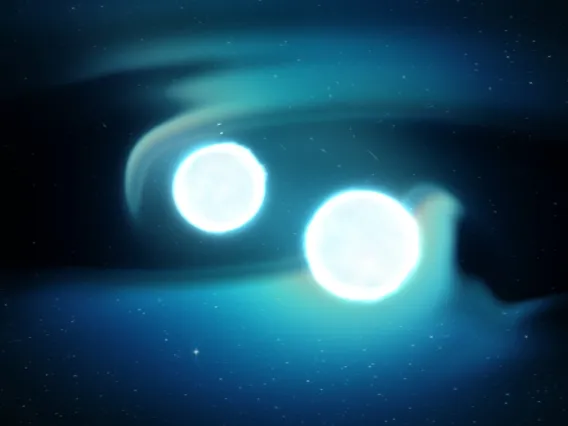
Best of Both Worlds: Asteroids and Massive Mergers
LPL researchers are using the Catalina Sky Survey’s near-Earth object telescopes to locate the optical counterparts to gravitational waves triggered by massive mergers.
Best of Both Worlds: Asteroids and Massive Mergers
×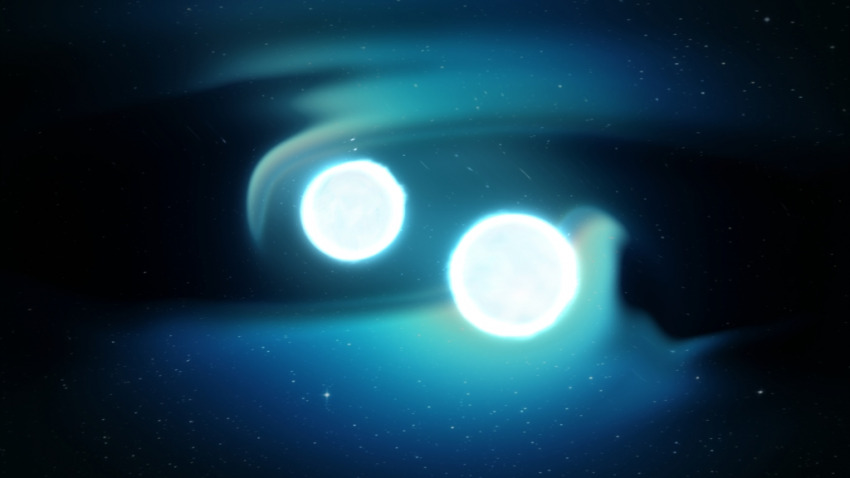
By Mikayla Mace, University Communications - August 14, 2019
The race is on. Since the construction of technology able to detect the ripples in space and time triggered by collisions from massive objects in the universe, astronomers around the world have been searching for the bursts of light that could accompany such collisions, which are thought to be the sources of rare heavy elements.
The University of Arizona’s Steward Observatory has partnered with the Catalina Sky Survey, which searches for near-Earth asteroids from atop Mount Lemmon, in an effort dubbed Searches after Gravitational Waves Using ARizona Observatories, or SAGUARO, to find optical counterparts to massive mergers.
“Catalina Sky Survey has all of this infrastructure for their asteroid survey. So we have deployed additional software to take gravitational wave alerts from LIGO (the Laser Interferometer Gravitational-Wave Observatory) and the Virgo interferometer then notify the survey to search an area of sky most likely to contain the optical counterpart,” said Michael Lundquist, postdoctoral research associate and lead author on the study published today in the Astrophysical Journal Letters.
“Essentially, instead of searching the next section of sky that we would normally, we go off and observe some other area that has a higher probability of containing an optical counterpart of a gravitational wave event,” said Eric Christensen, Catalina Sky Survey director and Lunar and Planetary Laboratory senior staff scientist. “The main idea is we can run this system while still maintaining the asteroid search.”
The ongoing campaign began in April, and in that month alone, the team was notified of three massive collisions. Because it is difficult to tell the precise location from which the gravitational wave originated, locating optical counterparts can be difficult.
According to Lundquist, two strategies are being employed. In the first, teams with small telescopes target galaxies that are at the right approximate distance, according to the gravitational wave signal. Catalina Sky Survey, on the other hand, utilizes a 60-inch telescope with a wide field of view to scan large swaths of sky in 30 minutes.
Three alerts, on April 9, 25 and 26, triggered the team’s software to search nearly 20,000 objects. Machine learning software then trimmed down the total number of potential optical counterparts to five.
The first gravitational wave event was a merger of two black holes, Lundquist said.
“There are some people who think you can get an optical counterpart to those, but it’s definitely inconclusive,” he said.
The second event was a merger of two neutron stars, the incredibly dense core of a collapsed giant star. The third is thought to be a merger between a neutron star and a black hole, Lundquist said.
While no teams confirmed optical counterparts, the UA team did find several supernovae. They also used the Large Binocular Telescope Observatory to spectroscopically classify one promising target from another group. It was determined to be a supernova and not associated with the gravitational wave event.
“We also found a near-Earth object in the search field on April 25,” Christensen said. “That proves right there we can do both things at the same time.”
They were able to do this because Catalina Sky Survey has observations of the same swaths of sky going back many years. Many other groups don’t have easy access to past photos for comparison, offering the UA team a leg up.
“We have really nice references,” Lundquist said. “We subtract the new image from the old image and use that difference to look for anything new in the sky.”
“The process Michael described,” Christensen said, “starting with a large number of candidate detections and filtering down to whatever the true detections are, is very familiar. We do that with near-Earth objects, as well.”
The team is planning on deploying a second telescope in the hunt for optical counterparts: Catalina Sky Survey’s 0.7-meter Schmidt telescope. While the telescope is smaller than the 60-inch telescope, it has an even wider field of view, which allows astronomers to quickly search an even larger chunk of sky. They’ve also improved their machine learning software to filter out stars that regularly change in brightness.
"Catalina Sky Survey takes hundreds of thousands of images of the sky every year, from multiple telescopes. Our survey telescopes image the entire visible nighttime sky several times per month, then we are looking for one kind of narrow slice of the pie," Christensen said. “So, we’ve been willing to share the data with whoever wants to use it.”
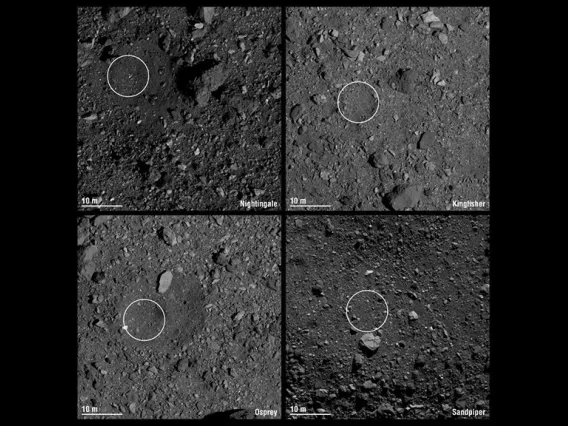
NASA Mission Selects Final Four Site Candidates for Asteroid Sample Return
Four locations on the asteroid Bennu have been selected as potential sample sites for the OSIRIS-REx spacecraft.
NASA Mission Selects Final Four Site Candidates for Asteroid Sample Return
×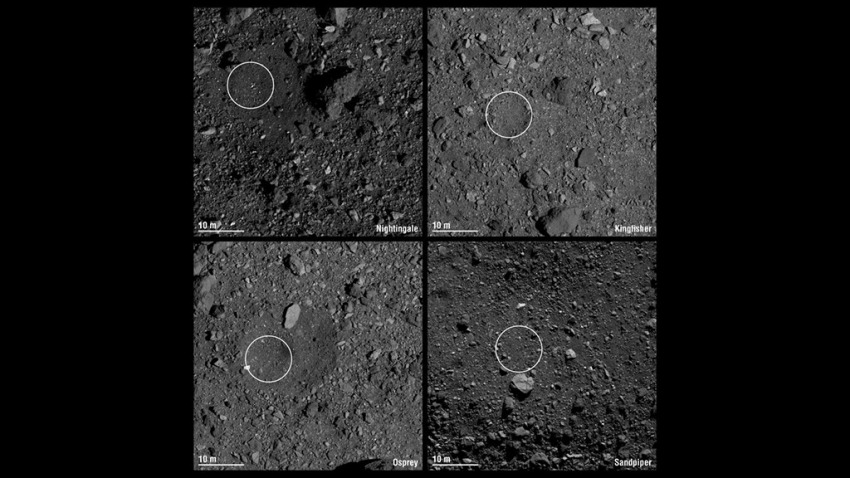
By Brittany Enos & Erin Morton, OSIRIS-REx - August 13, 2019
After months grappling with the rugged reality of asteroid Bennu’s surface, the team leading NASA’s first asteroid sample return mission has selected four potential sites for the Origins, Spectral Interpretation, Resource Identification, Security-Regolith Explorer, or OSIRIS-REx, spacecraft to “tag” its cosmic dance partner.
Since its arrival in December 2018, the OSIRIS-REx spacecraft has mapped the entire asteroid in order to identify the safest and most accessible spots for the spacecraft to collect a sample. These four sites now will be studied in further detail in order to select the final two sites – a primary and backup – in December.
The team originally had planned to choose the final two sites by this point in the mission. Initial analysis of Earth-based observations suggested the asteroid’s surface likely contains large “ponds” of fine-grain material. The spacecraft’s earliest images, however, revealed Bennu has an especially rocky terrain. Since then, the asteroid’s boulder-filled topography has created a challenge for the team to identify safe areas containing sampleable material, which must be fine enough – less than 1 inch (2.5 cm) in diameter – for the spacecraft’s sampling mechanism to ingest it.
“We knew that Bennu would surprise us, so we came prepared for whatever we might find,” said Dante Lauretta, OSIRIS-REx principal investigator at the University of Arizona. “As with any mission of exploration, dealing with the unknown requires flexibility, resources and ingenuity. The OSIRIS-REx team has demonstrated these essential traits for overcoming the unexpected throughout the Bennu encounter.”
The original mission schedule intentionally included more than 300 days of extra time during asteroid operations to address such unexpected challenges. In a demonstration of its flexibility and ingenuity in response to Bennu’s surprises, the mission team is adapting its site selection process. Instead of down-selecting to the final two sites this summer, the mission will spend an additional four months studying the four candidate sites in detail, with a particular focus on identifying regions of fine-grain, sampleable material from upcoming, high-resolution observations of each site. The boulder maps that citizen science counters helped create through observations earlier this year were used as one of many pieces of data considered when assessing each site’s safety. The data collected will be key to selecting the final two sites best suited for sample collection.
In order to further adapt to Bennu’s ruggedness, the OSIRIS-REx team has made other adjustments to its sample site identification process. The original mission plan envisioned a sample site with a radius of 82 feet (25 m). Boulder-free sites of that size don’t exist on Bennu, so the team has instead identified sites ranging from 16 to 33 feet (5 to 10 m) in radius. In order for the spacecraft to accurately target a smaller site, the team reassessed the spacecraft’s operational capabilities to maximize its performance. The mission also has tightened its navigation requirements to guide the spacecraft to the asteroid’s surface, and developed a new sampling technique called “Bullseye TAG,” which uses images of the asteroid surface to navigate the spacecraft all the way to the actual surface with high accuracy. The mission’s performance so far has demonstrated the new standards are within its capabilities.
“Although OSIRIS-REx was designed to collect a sample from an asteroid with a beach-like area, the extraordinary in-flight performance to date demonstrates that we will be able to meet the challenge that the rugged surface of Bennu presents,” said Rich Burns, OSIRIS-REx project manager at NASA’s Goddard Space Flight Center in Greenbelt, Maryland. “That extraordinary performance encompasses not only the spacecraft and instruments, but also the team who continues to meet every challenge that Bennu throws at us.”
The four candidate sample sites on Bennu are designated Nightingale, Kingfisher, Osprey, and Sandpiper – all birds native to Egypt. The naming theme complements the mission’s two other naming conventions – Egyptian deities (the asteroid and spacecraft) and mythological birds (surface features on Bennu).
The four sites are diverse in both geographic location and geological features. While the amount of sampleable material in each site has yet to be determined, all four sites have been evaluated thoroughly to ensure the spacecraft’s safety as it descends to, touches and collects a sample from the asteroid’s surface.
Nightingale is the northern-most site, situated at 56 degrees north latitude on Bennu. There are multiple possible sampling regions in this site, which is set in a small crater encompassed by a larger crater 459 feet (140 m) in diameter. The site contains mostly fine-grain, dark material and has the lowest albedo, or reflection, and surface temperature of the four sites.
Kingfisher is located in a small crater near Bennu’s equator at 11 degrees north latitude. The crater has a diameter of 26 feet (8 m) and is surrounded by boulders, although the site itself is free of large rocks. Among the four sites, Kingfisher has the strongest spectral signature for hydrated minerals.
Osprey is set in a small crater, 66 feet (20 m) in diameter, which is also located in Bennu’s equatorial region at 11 degrees north latitude. There are several possible sampling regions within the site. The diversity of rock types in the surrounding area suggests that the regolith within Osprey may also be diverse. Osprey has the strongest spectral signature of carbon-rich material among the four sites.
Sandpiper is located in Bennu’s southern hemisphere, at 47 degrees south latitude. The site is in a relatively flat area on the wall of a large crater 207 ft (63 m) in diameter. Hydrated minerals are also present, which indicates that Sandpiper may contain unmodified water-rich material.
This fall, OSIRIS-REx will begin detailed analyses of the four candidate sites during the mission’s reconnaissance phase. During the first stage of this phase, the spacecraft will execute high passes over each of the four sites from a distance of 0.8 miles (1.29 km) to confirm they are safe and contain sampleable material. Closeup imaging also will map the features and landmarks required for the spacecraft’s autonomous navigation to the asteroid’s surface. The team will use the data from these passes to select the final primary and backup sample collection sites in December.
The second and third stages of reconnaissance will begin in early 2020 when the spacecraft will perform passes over the final two sites at lower altitudes and take even higher resolution observations of the surface to identify features, such as groupings of rocks that will be used to navigate to the surface for sample collection. OSIRIS-REx sample collection is scheduled for the latter half of 2020, and the spacecraft will return the asteroid samples to Earth on Sept. 24, 2023.
Goddard provides overall mission management, systems engineering, and safety and mission assurance for OSIRIS-REx. Dante Lauretta of the University of Arizona, Tucson, is the principal investigator, and the University of Arizona leads the science team and the mission’s science observation planning and data processing. Lockheed Martin Space in Denver built the spacecraft and is providing flight operations. Goddard and KinetX Aerospace are responsible for navigating the spacecraft. OSIRIS-REx is the third mission in NASA’s New Frontiers Program, which is managed by NASA’s Marshall Space Flight Center in Huntsville, Alabama, for the agency’s Science Mission Directorate in Washington.
To explore the final four candidate sites in detail, click here.
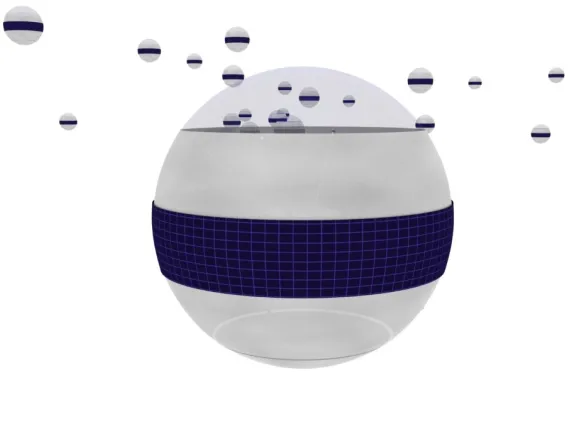
A New Lens for Life-Searching Space Telescopes
UA researchers have designed a new kind of telescope that is a cheaper, lighter and more powerful option than creating telescopes using ever-larger mirrors. With a fleet of the newly designed space telescopes, they aim to scour a thousand worlds for the chemical signatures of life.
A New Lens for Life-Searching Space Telescopes
×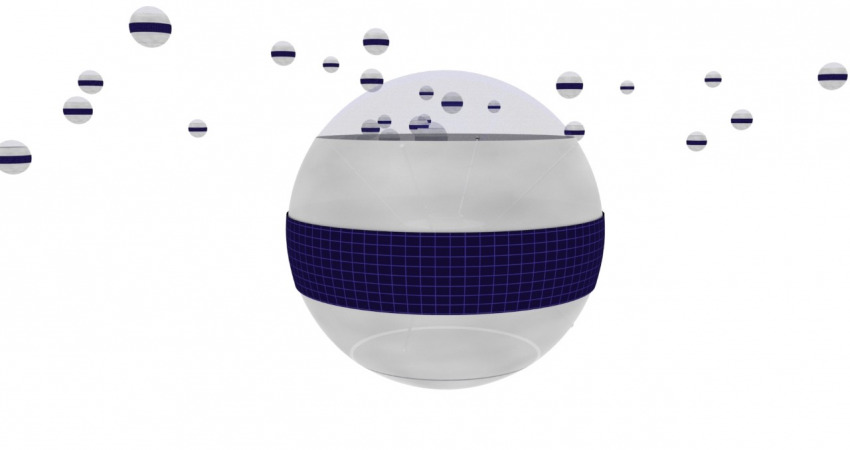
By Makayla Mace, University Communications - August 7, 2019
The University of Arizona Richard F. Caris Mirror Laboratory is a world leader in the production of the world’s largest telescope mirrors. In fact, it is currently fabricating mirrors for the largest and most advanced earth-based telescope: The Giant Magellan Telescope.
But there are size constraints, ranging from the mirror’s own weight, which can distort images, to the size of our freeways and underpasses that are needed to transport finished pieces. Such giant mirrors are reaching their physical limits, but when they do, the UA will continue to be a global contributor to the art of gathering light and drive change in the way astronomers observe the stars.
“We are developing a new technology to replace mirrors in space telescopes,” said UA associate professor Daniel Apai, of Steward Observatory and the Lunar and Planetary Laboratory. “If we succeed, we will be able to vastly increase the light-collecting power of telescopes, and among other science, study the atmospheres of 1,000 potentially earth-like planets for signs of life.”
Apai leads the space science half of the team, while UA professor Tom Milster, of the James C. Wyant College of Optical Sciences, leads the optical design of a replicable space telescope dubbed Nautilus. The researchers intend to deploy a fleet of 35 14-meter-wide spherical telescopes, each individually more powerful than the Hubble Space Telescope.
Each unit will contain a meticulously crafted 8.5-meter diameter lens, which will be used for astronomical observations. One use particularly exciting for Apai is analyzing starlight as it filters through planetary atmospheres, a technique which could reveal chemical signatures of life.
When combined, the telescope array will be powerful enough to characterize 1,000 extrasolar planets from as far away as 1,000 light years. Even NASA’s most ambitious space telescope missions are designed to study a handful of potentially Earth-like extrasolar planets.
“Such a sample may be too small to truly understand the complexity of exo-earths,” according to Apai and Milster’s co-authored paper, which was published July 29 in the Astronomical Journal along with several other authors, including Steward Observatory astronomer Glenn Schneider and Alex Bixel, an astronomer and UA graduate student.
To develop Nautilus, Apai and Milster defined a goal and designed Nautilus to meet it.
“We wanted to search 1,000 potentially earth-like planets for signs of life. So, we first asked, what kinds of stars are most likely to host planets? Then, how far do we need to go in space to have 1,000 earth-like planets orbiting around them? It turned out that it’s over 1,000 light years – a great distance, but still just a small part of the galaxy,” Apai said. “We then calculated the light collecting power needed, which turned out to be the equivalent of a 50-meter diameter telescope.”
The Hubble mirror is 2.4 meters in diameter and the James Webb Space Telescope mirror is 6.5 meters in diameter. Both were designed for different purposes and before exoplanets were even discovered.
“Telescope mirrors collect light – the larger the surface, the more starlight they can catch,” Apai said. “But no one can build a 50-meter mirror. So we came up with Nautilus, which relies on lenses, and instead of building an impossibly huge 50-meter mirror, we plan on building a whole bunch of identical smaller lenses to collect the same amount of light.”
The lenses were inspired by lighthouse lenses – large but lightweight – and include additional tweaks such as precision carving with diamond-tipped tools. The patented design, which is a hybrid between refractive and diffractive lenses, make them more powerful and suitable for planet hunting, Milster said.
Because the lenses are lighter than mirrors, they are less expensive to launch into space and can be made quickly and cheaply using a mold. They are also less sensitive to misalignments, making telescopes built with this technology much more economical. Much like Ford did for cars, Ikea did for furniture, and SpaceX for rockets, Nautilus will use new technology, a simpler design, and lightweight components to provide cheaper and more efficient telescopes with more light-collecting power.
Nautilus telescopes also don’t require any fancy observing technique.
“We don’t need extremely high-contrast imaging. We don’t need a separate spacecraft with a giant starshade to occult the planet host stars. We don’t need to go into the infrared," Apai said. "What we do need is to collect lots of light in an efficient and cheap way.”
In the last few decades, computers, electronics and data-collection instruments have all become smaller, cheaper, faster and more efficient. Mirrors, on the other hand, are exceptions to this growth as they haven’t seen big cost reductions.
“Currently, mirrors are expensive because it takes years to grind, polish, coat and test,” Apai said. Their weight also makes them expensive to launch. “But our Nautilus technology starts with a mold, and often it takes just hours to make a lens. We also have more control over the process, so if we make a mistake, we don’t need to start all over again like you may need to with a mirror.”
Additionally, risk would be distributed over many telescopes, so if something goes wrong, the mission isn’t scrapped. Many telescopes remain.
“Everything is simple, cheap and replicable, and we can collect a lot of light,” Apai said.
Apai and Milster have another vision if they succeed: “Using the low-cost, replicated space telescope technology, universities would be able to launch their own small, Earth- or space-observing telescopes. Instead of competing for bits of time on Hubble, they’d get their own telescope, controlled by their own teams,” Apai said.
In January, Apai and Milster's team, along with UA assistant professor Dae Wook Kim and professor Ronguang Liang of the College of Optical Sciences and Jonathan Arenberg from Northrop Grumman Aerospace Systems, received $1.1 million from the Moore Foundation to create a prototype of a single telescope and test it on the 61-inch Kuiper Telescope on Mt. Bigelow by December 2020.
“The University of Arizona is just one of the few places in the world, and usually the first in the world, to generate such pioneering telescope systems,” Milster said. “And it fits right in line with our history and our prominence in optical sciences and astronomy that we develop this technology.”
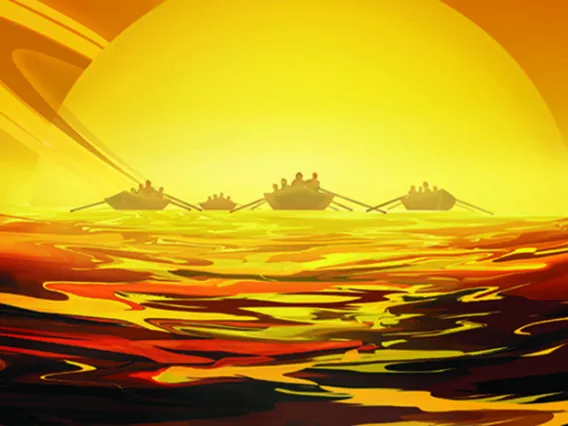
Travel to Alien Moons with UA Expert Guides
Humans first explored the Earth’s moon 50 years ago, an impressive feat for sure. But if you are interested in venturing a little off the beaten path, here are some other extraordinary moons to visit in the future.
Travel to Alien Moons with UA Expert Guides
×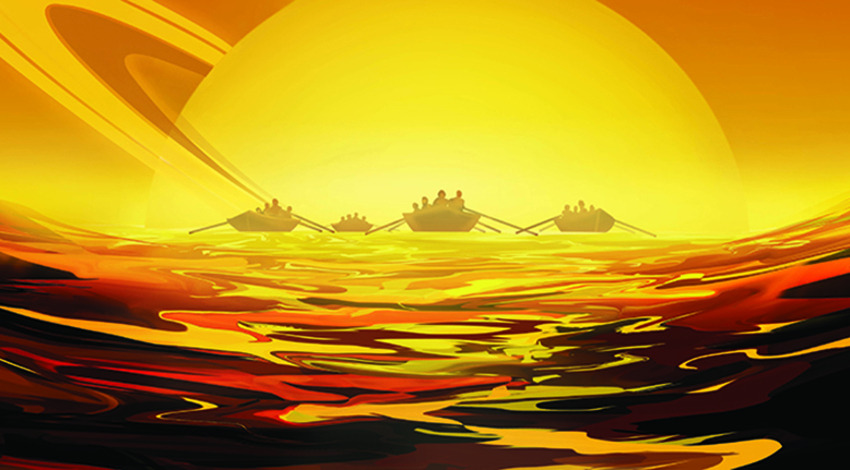
By Mikayla Mace and Daniel Stolte, University Communications - July 22, 2019
Pit Stop on Phobos
Your guide: Alfred McEwen, UA Regents' Professor of Planetary Sciences and principal investigator of HiRISE, the sharpest camera ever sent to another planet
As you pack up your spaceship in preparation for decades of travel, you’re sure to feel like you’re forgetting something. Don’t worry! After about nine months of listening to “are we there yet” – even when traffic is at its lightest and Mars is at its closest to Earth – one of the red planet’s moons, Phobos, is the pit-stop you need.
Although its origin is still disputed, Phobos could be a specific type of captured asteroid that is rich in water, a valuable resource for space exploration and mining. While you’re buying replacement chargers and anti-nausea pills, let the kids out to stretch their legs on this seven-mile-wide moon. As they leap about in gravity about 100 times weaker than Earth's, you should fill up your futuristic fuel tanks with water stored under the Martian moon’s surface. The fuel station’s ease of access is granted by a gravitational tug much weaker than Mars’.
While you’re there, explore the disorientingly close horizons that are distorted by Phobos' small size and rugged terrain. You’ll feel as though you are standing in an Earthly canyon and notice that its surface is surprisingly dusty, like Earth’s moon. Make sure to stop by the largest feature on Phobos, the more than five-mile-wide Stickney crater, before blasting off to the outer solar system.
Don't want to drive? Maybe you can catch a ride: Plans are in the works for Japan to send a sample return mission to the mysterious moon.
Visit the Underworld on Io
Your guide: Alfred McEwen, interdisciplinary scientist on the Galileo mission to Jupiter
Jupiter's innermost moon Io is a wicked place for only the most extreme thrill seekers. Most of what is known about Io comes from the Galileo spacecraft, which studied the Jupiter system in detail between 1995 and 2006. If you park your starship on the nighttime side, your eyes will first fall on sprawling lava flows glowing across the color spectrum because of the various elements melting within. Hundreds of volcanoes pockmark the surface of Io, each one more active than the most active volcano on Earth: Kilauea.
Make sure to take a tour of Io's top sites. The Loki caldera, or sea of lava, is the largest active volcano in the solar system. Pele, named after the goddess of volcanology of Hawai’i, is smaller than Loki but is ringed by red deposits the size of Texas (where everything’s bigger) and is one of the moon’s most prominent features.
While you might not hear the grumblings of the restless moon through the tenuous atmosphere, you will feel the terrain bucking beneath your soles and the swelling solid-body tides that reach more than 160 feet! All this activity is fueled by the planet Jupiter, which Io orbits every two Earth days, and the other large moons which regularly align to tug gravitationally on Io, heating the rocks to create the magma within.
With features named after the gods and goddesses of the underworld littering the surface, you might think you’ve died and gone to Hades. But don’t fret, Io isn't Hades, though it is a hellish place in which there are many ways to die.
You could land in a boiling caldera and vaporize. Alternatively, you could land too far away from it and freeze to death. But freezing would be a slow, sad way to leave any world, and it’s likely that on Io, you’d run out of air first. If you desperately scrambled for breath, you’d find that the thin atmosphere is actually poisonous, and your last breaths of air would smell of rotten eggs due to Io's sulfurous surface. Yet no matter how carefully you tread across the spectacularly vivid moon, the intense radiation generated by Jupiter’s magnetic field would unrelentingly destroy your cells. The noxious surface could even challenge the hardiest of robotic spacecraft. Be prepared!
Cool Off on the Solar System’s Icy Moons
Your guide: Veronica Bray, UA Lunar and Planetary Laboratory associate staff scientist developing a seismometer for a potential Europa lander
After visiting the volcanic world of Io, cool off in the frigid waters of another Jovian moon: Europa. Upon landing, you’ll notice Europa is the smoothest moon in the solar system. An icy surface of disputed thickness floats above a briny liquid ocean. The moon’s topography varies by only about 6,500 feet. The relative lack of craters and smoothness is due to a combination of geologic activity and a warm ice shell, resulting in topographic features that relax back toward a level plain.
But before you whip out your ice skates to glide along the ruddy fault lines that cut across the surface as a result of tidal squeezing, find shelter. If you are adventurous, you could set up camp in a deep ice cave; if your tastes are more refined, you might prefer a five-star hotel carved and stabilized within the ice layer. Similar to Io, on Europa, radiation from Jupiter would wreck your spaceship and your body, but water ice acts as a protective shield.
Hopefully, you’ll book ahead for the occult submarine tours in which you try to spot a Europan giant squid, though reports of their sightings have not been confirmed. Scientists think life, even bacterial life, might thrive in warm water vents on the ocean floor warmed by tidal forces.
While you might be slightly nervous about having miles of ice and water above your head, just remember that Europa’s gravity is about the same as Earth’s moon, so the pressure will not be greater than what a submarine can tolerate in the depths of Earth’s oceans. If the depths don’t get under your skin, then it’s likely that the creaking and groans of rock-hard ice echoing through the pitch-black ocean won’t either. Europan tides are responsible for the noise.
If you decide to brave the surface, acquire a certified spacesuit that protects against radioactivity. You’ll find that about 60 craters remain on Europa, which is relatively few for a moon with no atmosphere to erode surface features. The geologic activity is so great that the surface is very young. Also on the surface you might need to dodge "penitentes," vicious spikes of frozen snow sculpted by the dancing sun.
If frozen sea worlds aren’t your thing and you want to spend more time on land, travel to Saturn's tiny icy moon Enceladus to catch some powder.
Like an arctic Yellowstone, geysers erupt in Enceladus’s southern hemisphere from fissures in the surface layer of ice, much like Europa. The spray of subsurface water likely supplies fresh snow for skiing, snowboarding and sledding, and the low gravitational tug of a moon with a diameter six times smaller than Europa means you can take on steeper slopes and get more air.
What to pack: Enceladus is the brightest moon in our solar system, so bring sunglasses! Snowshoes and an umbrella can protect you from sinking into the snow or getting buried as the frozen spray falls to the ground.
A Moon like Earth, Except Totally Different: Titan
Your guide: Alfred McEwen, member of the imaging science team of the Cassini mission to Saturn
Titan, Saturn’s largest natural satellite, draws astrobiologists like moths to a flame. Observations made during fly-bys of NASA's Cassini spacecraft reveal glimpses of a mesmerizingly alien landscape of mountains, rolling hills and valleys, complete with meandering streams and lakes. Underneath its surprisingly Earth-like surface, Titan is thought to harbor a vast underground ocean of liquid water. That discovery, made only fairly recently, adds Titan to the handful of worlds in our solar system that could potentially contain habitable environments.
Titan, which is about the size of planet Mercury, offers some of the most spectacular views and experiences our solar system as to offer. For much of the final descent through Titan's atmosphere, which is thick with an orangish shroud of nitrogen and smog, you wouldn't see a lot. Picture Los Angeles on a really bad day during rush hour, multiply that by 1,000, and you get the idea.
As you approach the surface, though, ridges of steep mountains come into view, as do sand dunes and gullies carved by rushing liquid. At times, you'll catch a glint from the glass-like surface of a distant lake. Once on the ground, don a heavy space suit to protect you from Titan's harsh (in Earth terms, "polluted") atmosphere and extreme cold before you start exploring.
Your first excursion onto Titan's surface should be to visit a historic artifact: the Huygens lander – or what's left of it. The only human-made object to ever touchdown on a moon other than Earth's, the probe hitched a ride on the Cassini spacecraft with a mission to study Titan up close. Once Huygens cast off from its mothership, it hurtled toward Titan and was soon swallowed by the orange haze that hides the moon from view. Dangling from a parachute, Huygens spent two-and-a-half hours floating down toward the surface, snapping pictures with its UA-built descent imager and taking all sorts of measurements.
Next, take a leisurely trot around the shore of one of Titan's famous lakes. Where else in the solar system could you skip rocks across an endless expanse of liquid methane? Wrap up your trip with another highlight: Strap on a set of wings and, after a brief orientation on how to steer and safely land, take off and flap to new horizons, supported by Titan's dense atmosphere. Isn’t zip-lining so 2000's?
Book your travel early – NASA just approved the Dragonfly mission, which will send a quadcopter to Titan in 2034.
Looking for the Fringe? Here’s a Strange Moon You’ve Never Heard of
Your guide: Erich Karkoschka, Lunar and Planetary senior staff scientist and expert on Neptune, the pale blue giant
If you’re the type who avoids tourist crowds and finds Jupiter’s and Saturn’s moons too mainstream, consider a trip to Neso. Don’t worry if you’ve never heard of it – most people haven’t. Named after the Nereids, female water spirits in Greek mythology who accompany Poseidon, god of the ocean, Neso is the fringiest of several dozens of moons that belong to the outermost planet of the solar system: Neptune (which is how the Romans referred to Poseidon).
It’s no coincidence that Neso gets short shrift in most glossy tourism ads: This strange world is so far out that nobody knows for sure what it looks like, how big it is or how long a day lasts on its surface. What is fairly certain is that none of the other known moons get as far away from their host planet as Neso does. Its orbit is so oblong that a Neptunian observer enjoying a Neso full moon would have to wait more than a quarter-century to see another. That said, it would not be a huge loss, as attempting to spot Neso from Neptune is pretty futile to begin with, and vice versa. If you want to catch a glimpse of Neptune while standing on Neso, the big gas planet would be barely visible as a disc — not quite the breathtaking blue-marble-rising-above-the-moon, one-for-the-ages shot the Apollo astronauts managed to capture on film. The sun, too, would just be a shiny dot in the sky above Neso, just bright enough to allow you to enjoy some vacation reading.
Popular with the scruffy backpacker crowd, Neso is not for you if you consider dependable public transportation or cushy rental cars non-negotiables. But here’s the good news: Because Neso is estimated to be a mere 40 miles or thereabouts in diameter, its gravity is low enough that you can hike – or rather, hop – around the whole thing in a day or so, and it would take you just a few hundred steps. They’d be big, slow and long steps, each lasting for about five minutes. Don't worry about dropping your phone on Neso – it would take almost 30 seconds to make it to the ground, giving you plenty of time to catch it before having to check your travel selfies on a spiderwebbed screen.
While the starry night sky at the edge of the solar system likely is a sight to behold, stargazers should beware: the nightly lows on Neso spell serious trouble to the un(der)prepared. On Triton, another one of Neptune’s moons, temps go down to minus 391 degrees Fahrenheit, and while Triton holds the record as the solar system’s coldest object, Neso is unlikely to be any cozier. So be sure to bring some extra space blankets before heading out to stargaze.
Other useful items to carry on Neso include a quality flashlight, a healthy stockpile of batteries, boots with cleats to navigate rock-hard ice and pocket warmers (preferably the portable, nuclear generator kind because solar-powered devices won't work this far out).
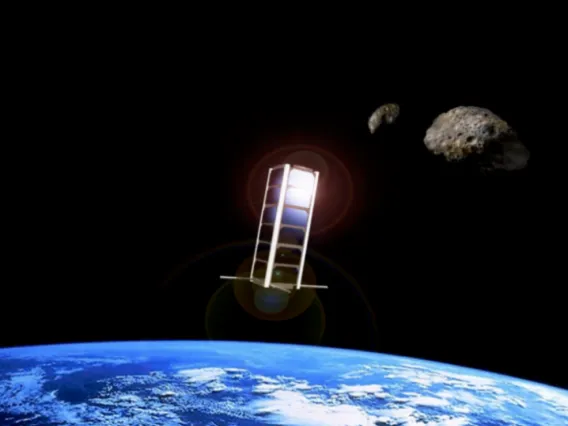
$3M in NASA Funding to Help Students Build CubeSats
NASA's Minority University Research and Education Project Institutional Research Opportunity program will give students in Arizona and Puerto Rico the opportunity to collaborate with scientists and engineers on the next generation of space exploration technology.
$3M in NASA Funding to Help Students Build CubeSats
×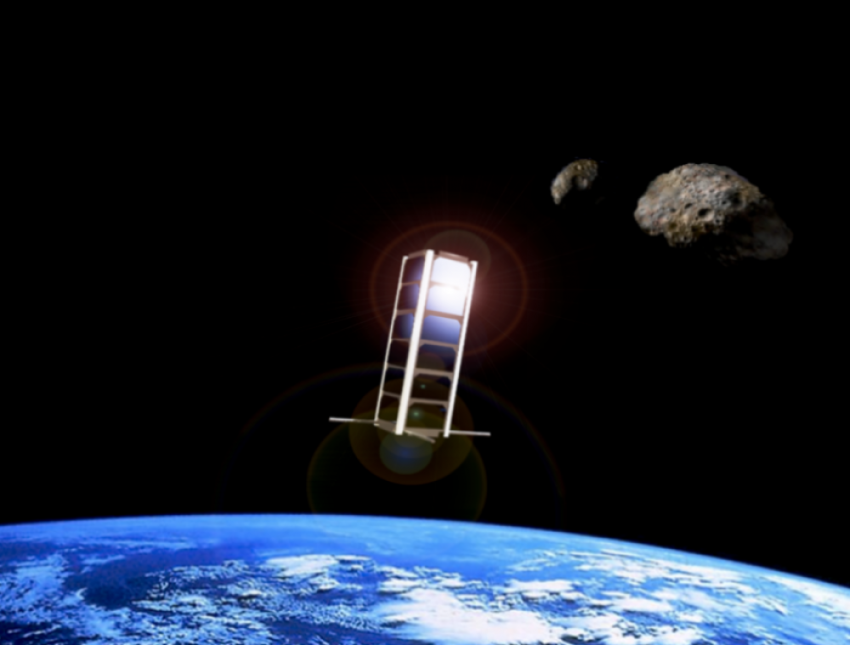
By Emily Dieckman, College of Engineering - July 17, 2019
University of Arizona researchers will use $3 million in NASA funding over three years to research the low-gravity surface environments of asteroids, and to provide students from underrepresented backgrounds the opportunity to design, build and operate CubeSats, or miniature satellites at the UA.
The project was selected through NASA's Minority University Research and Education Project Institutional Research Opportunity, or MIRO, program. The UA, which was designated a Hispanic-Serving Institution in 2018, is one of eight institutions to receive a share of more than $8.2 million in cooperative agreements awarded through the MIRO program.
"This project will help us understand asteroid surface geophysics in a way that no one has done before," said Erik Asphaug, deputy principal investigator for the project and a professor in the UA Lunar and Planetary Laboratory. "And the students get to participate in a low-cost endeavor that has huge implications for how we work with asteroids in near-Earth space."
There are many reasons to study asteroids, from the way they affect humans when their orbits cross paths with Earth, to their potential as sources of spacecraft fuel, to the clues they may hold about the origins of planets and life. But it's difficult and expensive to send missions to asteroids, and it's impossible to simulate their low-gravity environments – where a human would weigh as much as a mouse – on Earth for long durations.
The answer is to build a lab in space, according to Jekan Thanga, principal investigator of the MIRO project, head of the UA SpaceTREx Laboratory and assistant professor in the Department of Aerospace and Mechanical Engineering.
The project will recreate the surface environments of asteroids by placing asteroid origins satellites, or AOSATs, small laboratories containing asteroid material that came to the Earth in the form of meteorites, into low-Earth orbit. Rotating at about the speed of the second hand on a clock, each AOSAT will generate a centrifugal force equivalent to an asteroid's extremely low surface gravity. Scientists can't recreate asteroid gravity in this manner onboard the International Space Station because it is too subtle of a force – smaller than the vibrations from the pumps and fans that keep the astronauts alive.
Because it's much cheaper and easier to operate a laboratory-spacecraft in low-Earth orbit than it is to spend hundreds of millions of dollars going all the way to an asteroid, AOSATs will offer repeated opportunities for basic science and act as a testbed for asteroid-bound hardware.
"We are coming up with an asteroid proving ground without having to go to an asteroid," Thanga said. "This is a whole different way of doing science."
Students from the UA, Pima Community College and the University of Puerto Rico will have the opportunity to build three AOSATs, each about the size of a loaf of bread. Then, they will operate them in low-Earth orbit, conducting basic research on their simulated "patch of asteroid." Research areas will include how to extract water for conversion into rocket fuel, testing robotic devices capable of digging and planting sensors on an asteroid, and sending bursts of gas and firing small projectiles into a low-gravity asteroid surface.
"This is a unique project which will provide students the opportunity to study different aspects of asteroid science," said Desiree Cotto-Figueroa, project co-investigator and assistant professor at the University of Puerto Rico at Humacao. "The continuous discovery of unknown near-Earth asteroids, as well as gaining an understanding of their origin and evolution, is very important."
Ultimately, the researchers envision AOSAT as pathway toward a significantly larger centrifugal spacecraft that could act as a semipermanent proving ground in low-Earth orbit. This accessible facility would allow researchers to realistically test how an entire lander or an astronaut might interact with an asteroid surface – what Asphaug calls a "persistent link" between distant asteroid environments and the Earth. Such a facility could even be used to recreate a "patch of the moon" where astronauts could train and adapt to the low-gravity lunar conditions humans first experienced in the Apollo missions 50 years ago.
"Our decades-spanning experience in planetary exploration makes the UA an ideal institution to lead this STEM education and research project," said UA President Robert C. Robbins. "Underrepresented students from both our local community and international partners will have an opportunity to learn about asteroid science and space systems engineering through a project that will actually launch into space. This is the kind of incredible opportunity we are proud to offer students for them to have the tools and experience to succeed."
In the near term, "we would like to build a pipeline of students working with professors to conceptualize, design, build and fly CubeSats at the University of Arizona," Thanga said. "We're looking to the day in the future where sending a CubeSat to space might be as easy as sending a payload up on a balloon flight to do an experiment in high altitude."
Roberto Furfaro, professor of systems and industrial engineering and head of the Space Situational Awareness Initiative under which SpaceTREx operates, said that with the help of the College of Engineering; the provost; and the Office of Research, Discovery and Innovation, he recruited Thanga specifically to be "the missing link" between CubeSat research and space situational awareness, or SSA, which is the ability to monitor, understand and predict the behavior of objects orbiting Earth.
"He represents what we call space-based SSA," Furfaro said. "He could potentially build a CubeSat that can not only view the Earth or other planetary bodies, but can observe other spacecraft or debris to learn more about the characteristics and behavior of objects in space, for example."
Other project collaborators include co-investigator Greg Ogden of the UA Department of Chemical and Environmental Engineering; co-investigator Dennis Just of Pima Community College; co-investigator Joseph Masiero of NASA's Jet Propulsion Laboratory; and Viranga Perera at the Johns Hopkins University Applied Physics Laboratory, who will be evaluating effectiveness and advising the team on how to meet diversity goals.
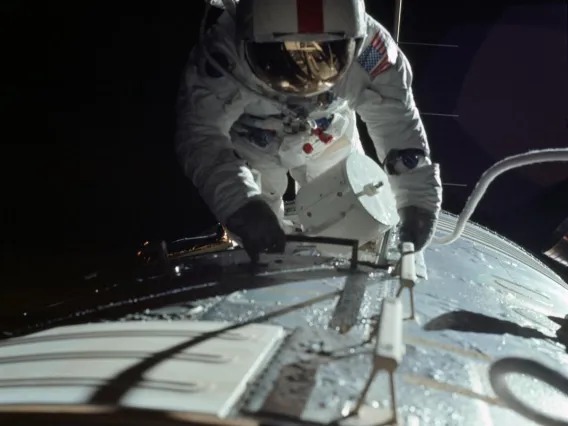
Mapping the Moon and Worlds Beyond
UA scientists were instrumental in creating the first photographic atlases of the moon, which helped NASA successfully complete the Apollo 11 mission. Fifty years later, UA scientists are busy mapping worlds throughout our solar system.
Mapping the Moon and Worlds Beyond
×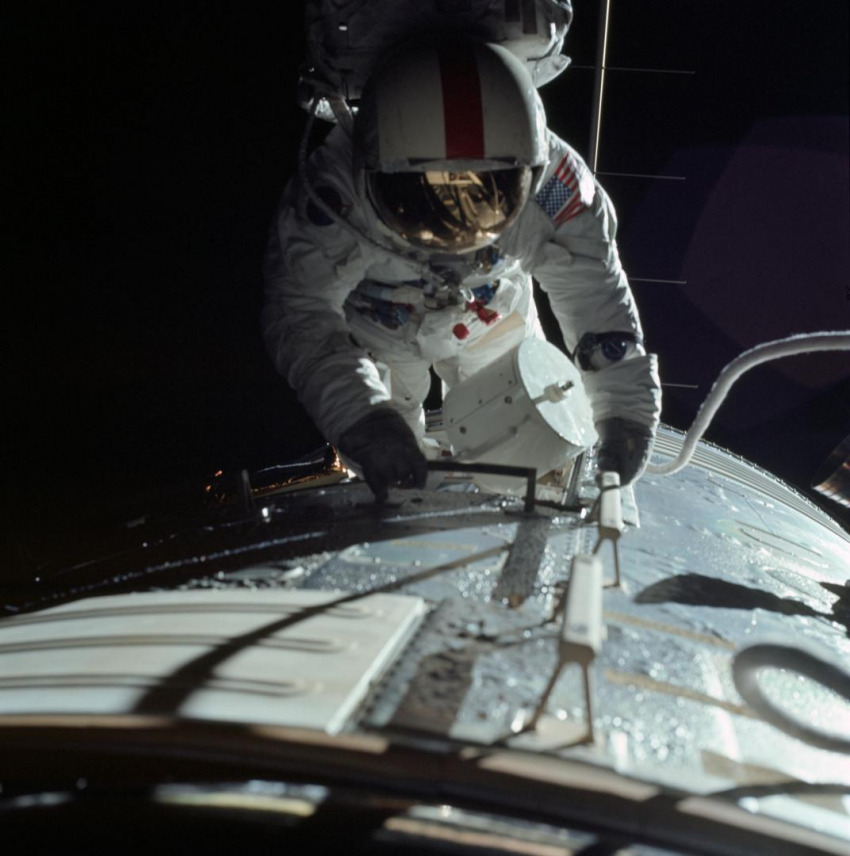
By Daniel Stolte, University Communications - July 16, 2019
In 1972, it took an astronaut going on a spacewalk to do what Lynn Carter now can do with a few mouse clicks over lunch.
Carter, a planetary science professor at the Univerity of Arizona Lunar and Planetary Laboratory, points to a small, framed photograph above her desk. It shows the Apollo 17 spacecraft, the last crewed mission to the moon, cruising high above the grey, cratered expanse below.
"See that little antenna sticking out there? That was the first planetary radar on a spacecraft, and while it went around the moon, it pinged the surface," she said. "Each time it hit a different rock layer, it reflected a signal and recorded it on film."
One of the things the Apollo 17 astronauts were tasked with doing was mapping the moon's surface from the bird's eye view of their orbiter. In addition to photographing the obvious – topographic features like hills, craters and boulders – the radar antenna allowed them to reveal hidden geologic features underneath the moon's surface. The radar data were recorded on old-fashioned cassette tapes stored underneath a hatch that was only accessible from outside the spacecraft. To retrieve the film, astronaut Ron Evans had to put on a spacesuit and wiggle through the hatch of the Apollo capsule while it hurtled through space somewhere between the moon and the Earth at almost 25,000 miles per hour.
"Today, it's totally different," Carter says. "Everything is digital, and the instruments have much better resolution. We can see things on Mars from our living room that you couldn't see even if you could travel there and stand on the surface yourself."
Mapping Other Worlds
Carter specializes in making maps of the unseen: using data obtained with ground-penetrating radar instruments, she visualizes and interprets features buried under the surface of planetary bodies like the moon, Mars and Venus.
To a planetary scientist like Carter, mapping another world is about much more than figuring out what is where on the surface and how to get from point A to point B (although navigation is becoming an increasingly important goal, with efforts ramping up to send astronauts to new horizons such as Mars or near-Earth asteroids).
"We look at planets to understand how they formed," Carter says, "and also to better understand features here on Earth that have been obscured by the very geologic processes that make our planet special. Studying other objects in the solar system is a way to study things that didn't turn out the way they did here on Earth."
Take Venus, for example, Earth's next-door neighbor and Carter's "favorite planet," as she readily admits. Even with the most powerful telescopes, we never get to see its surface, which is permanently shielded from view by a broiling shroud of clouds. Until the 1960s, sci-fi novels speculated about a lush, tropical world covered in jungles.
"Radar crushed that idea, as it unveiled a solid, super-hot surface with many volcanoes." Carter says. "All of a sudden, Venus did not look hospitable at all."
Unlike the explorers and cartographers who ventured out to map the Earth from land and sea, planetary scientists have to map from afar, looking through telescopes, or, if they're lucky enough to get a spacecraft mission funded, from orbit.
A Coffee Table on Mars?
One of the most successful visualization missions is HiRISE, which is led by the UA. HiRISE is a high-resolution imaging camera that has photographed Mars in unprecedented detail while orbiting the red planet aboard NASA's Mars Reconnaissance Orbiter for more than 10 years. The images are so detailed that over the course of a decade, after snapping 62,712 images, it has covered a mere 3.5% of the Martian surface. But coverage was never the goal – rather, HiRISE was sent to Mars to find future landing sites and to provide image that will help scientists understand the ancient and present-day geologic processes of Mars. The planet has proven to be surprisingly active in spite of the fact that it is a cold, dusty world lacking plate tectonics or a magnetic field and whose atmosphere largely wafted off into space.
HiRISE, whose eye is sharp enough to spot a coffee table (if there was one) on the ground from 180 miles above, is now in its fifth extension and still going strong. At the time it launched, similarly detailed maps of Earth were classified and only accessible to the individuals at the Pentagon, said Alfred McEwen, UA Regents' Professor of Planetary Sciences and principal investigator of HiRISE.
Since then, HiRISE has revealed a stunningly beautiful planet. The instrument's stereo vision, unprecedented resolution and repeated imaging passes completely changed how scientists interpreted previous images taken of the red planet, McEwen says.
"What we thought to be ancient dunes, for example, frozen in time for possibly millions of years, turned out to be changing constantly."
HiRISE has seen a whole suite of ongoing activity including new impact craters, where the impacting meteorite blasted water ice out from underneath the planet' surface, erosion gullies and other features, some so unearthly that planetary geologists like McEwen are still struggling to explain their origin with certainty.
"We keep finding new things, such as features in the polar regions that we call spiders," McEwen says. "We think they're caused by carbon dioxide gas flowing underneath ice sheets, carving the surface topography. Another recent discovery is boulders that slowly move downhill, possibly driven by the seasonal expansion and contraction of ice underground."
Taking pictures is only the first step in generating a map of a planetary surface accurate enough to allow landers to touch down without crashing into undiscovered boulders or prevent robotic rovers from getting stuck in loose sand.
"To make a map, you have to understand the geometry of your images and mosaic them together. And then you have to change the perspective to what it looks like straight down, unless the originals were acquired that way," McEwen said of the process called orthorectification.
Orthorectification is necessary to derive the topography from an image, he explains. The UA scientists who produced the first detailed atlas of the moon used a rather analog, but elegantly simple setupto accomplish this. These days, it is done by the keen eyes of specially trained people and sophisticated software.
Jupiter's Shapeshifting Satellites
Some of the other challenges facing cartographers of the solar system are how to define sea level when your object of study doesn't have a sea or how to nail down coordinates on an object that's not exactly spherical or constantly shifts its shape.
"Many of the Jupiter satellites are what we call triaxial ellipsoids," McEwen says. "Their three-dimensional shapes change with the strong tidal forces under Jupiter's gravitational field, and that is a real challenge if you want to do precision mapping."
Measuring such changes is interesting for its own sake, however, because it reveals clues about the interior properties of those objects that would be difficult or impossible to study otherwise, McEwen adds.
UA scientists and engineers have pushed the field forward by designing instruments and cameras that have flown on several space missions to map unknown territory, including Mercury, the planet closest to the sun, Saturn's moons Titan and Enceladus, and Jupiter’s moon Io. They also are working on proposed instruments for future mapping projects that include Earth's moon, Mars and Europa, Jupiter's large moon whose subsurface water ocean is considered a hot candidate for extraterrestrial life.
Most recently, UA scientists are nearing completion of the most detailed map ever made of any solar system body, including Earth: cameras designed at the UA are scanning the rocky surface of Bennu, a near-Earth asteroid about as tall as the Empire State Building, and the team of the UA-led OSIRIS-REx sample return mission mapped Bennu's surface down to the inch. Being able to select a safe site for the spacecraft to touch down and grab a sample is a logical prerequisite for the mission, which is poised to return a sample of pristine asteroid material to Earth in 2023.
"By the time we're done with the characterization of the candidate sample sites, we'll be able to see an object the size of a penny," says Daniella DellaGiustina, lead image processing scientist for OSIRIS-REx.
DellaGiustina adds that in addition to ensuring mission safety, mapping at such unprecedented detail delivers "really cool, incredible science."
"By getting a dataset of an entire asteroid and going from that scale all the way down to centimeter-sized pixel imaging, we can really begin connecting asteroids to the meteorite population we have in our labs," DellaGiustina says.
To do so, the team had to invent new techniques and augment available mapping software to capture an accurate representation of Bennu, an irregularly shaped object whose surface is studded with boulders, including some the size of a parking garage and with overhang.
Navigating in Three Dimensions
"One coordinate system is not enough, so we are working in both latitude and longitude and cartesian coordinates all the time," DellaGiustina says. "This allows us to generate 3D point clouds and assign precise coordinates to every pixel."
Covering new ground for future touch-down sites also is a declared goal of ongoing Mars research at the UA, including a shallow-ground radar mapping mission proposed by Lunar and Planetary Laboratory Deputy Director Shane Byrne. One of the requirements is to look for water ice deposits shallow enough that astronauts can get to them and use them as a resource for fuel and water. Meanwhile, the HiRISE team is currently scouting potential landing sites on Mars' midlatitudes for Elon Musk's Space X company.
Through recent hires of radar mapping experts, the UA has become one of the premier institutions for radar imaging science, says Ali Bramson, who recently graduated with a Ph.D. from the Department of Planetary Sciences and now is a postdoctoral fellow in Carter's group. Together with Eric Petersen, a postdoctoral fellow on the team of professor Jack Holt, who joined the Lunar and Planetary Laboratory last year, Bramson is part of a project that integrates datasets from many different imaging techniques to paint a more complete picture of ice hidden underneath the Martian surface. The goal is to produce a data product that could be used in planning crewed missions.
In addition to enabling future human exploration missions to Mars, this research helps answers fundamental questions about how the red planet came to be what it is today, Bramson explains.
"By mapping the subsurface ice, we can try to piece together the planet's climate history," she says. "This allows us understand the natural climate shifts without the confounding factors that we have on Earth, such as human population, vegetation and oceans."

Exploring A Desert Portal to Other Worlds
The merge between astronomy and geology, necessary to get humans to the moon, led to the birth of modern-day planetary science and a long history of field trips that continue to this day, enabling fledgling scientists to interpret data from far-off worlds without leaving Earth.
Exploring A Desert Portal to Other Worlds
×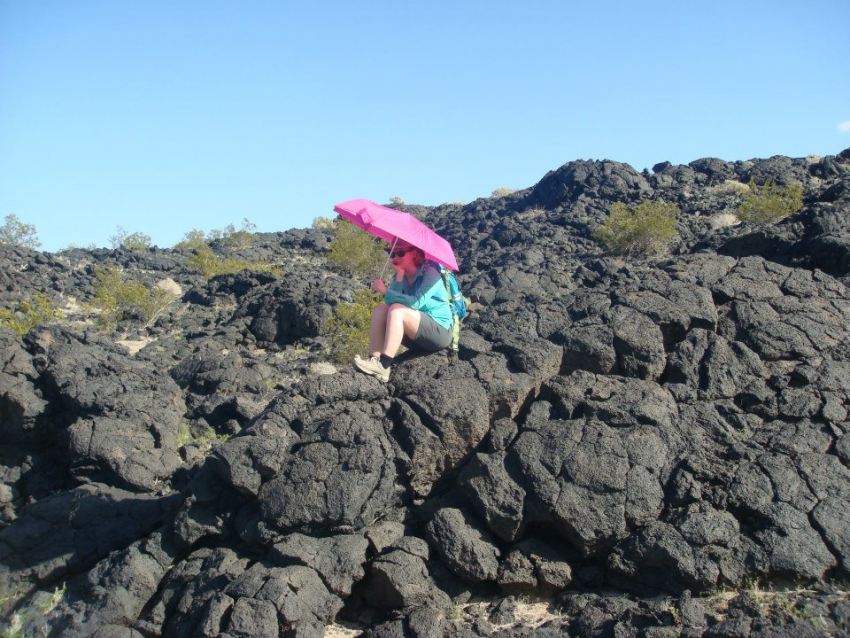
By Mikayla Mace, University Communications - July 8, 2019
Ali Bramson clutched her neon pink umbrella as she trekked across the frozen lava that spilled from Amboy Crater in California’s Mojave Desert. She and her fellow University of Arizona graduate students were tasked with identifying the boundaries of different eruptions of the extinct volcano, then unfurling their bright umbrellas to mark the spot. From an airplane overhead, her professor and another student photographed the sites to record the findings.
“We compared where we had mapped the different lava flows from the ground to where we had mapped the lava flows based on images taken from above by airplanes and satellites,” said Bramson, who is now a postdoctoral research fellow at the UA's Lunar and Planetary Laboratory, or LPL. “It was a great way to learn about how looking at geological features from different perspectives and spatial scales affects your interpretation.”
Bramson was one of the latest in a long history of LPL graduate students to take a planetary geology field trip to learn how Earth’s geological formations can serve as analogs to formations on the moon, Mars and beyond.
The tradition began more than 50 years ago – before Neil Armstrong and Edwin “Buzz” Aldrin left their bootprints in the moon's powdery soil – when UA researchers led by Gerard Kuiper worked with NASA to map and understand the moon’s surface from a geological perspective.
To do so, Kuiper’s graduate students studied field geology, which spurred the formation of the UA Department of Planetary Science and the field trips within it.
“The smallest features we could photograph from Earth were no more than a half-mile across, so the biggest problem was to understand the human-scale structure of the lunar surface,” said William Hartmann, one of Kuiper’s graduate students who helped create the Rectified Lunar Atlas. Hartmann later co-founded the Planetary Science Institute, or PSI, in Tucson. “To study possible lunar surface textures, we Kuiper graduate students in the early ‘60s – who had grown up in leafy-green, non-volcanic parts of the U.S. – made many camping trips.”
Desert Portal
Clear skies, clusters of telescopes, and thriving astronomy, geology, and atmospheric science programs lured Kuiper, considered the father of modern-day planetary science, to Southern Arizona in 1960. But it is the Sonoran Desert's arid climate that preserves the geological features of interest: impact and volcanic craters, lava flows, cinder cones, strata within canyons, and more.
“These geological processes are beautifully exposed and preserved in the Southwest,” said LPL assistant professor Christopher Hamilton, who co-leads the LPL graduate student field trips with Shane Byrne, assistant department head of planetary sciences. Their trips have allowed students to explore sites across the Sonoran Desert and as far away as Hawaii and Iceland.
“The field trips also offer a way to see things, like lava flows or sand dunes, up close that for other planets we often have to rely on images and data from spacecraft to study,” Bramson said. “It helps connect what we see from orbit or telescope to a ground truth by being able to walk around and sample similar features here on Earth.”
The Pinacate Peaks are one such example, and they are riddled with lunar analogs, according to Kuiper’s graduate students. More than 400 volcanic cinder cones and nine large volcanic craters have pockmarked the range, which is located mostly in the Mexican state of Sonora between the Arizona-Mexico border and Puerto Peñasco, and is surrounded by giant sand dunes.
“The Pinacate region has wonderful lava flows and big half-mile volcanic craters,” said Hartmann, who in 1989 wrote Desert Heart, a popular book about the area. “One of the big concerns was that the lunar surface might resemble extremely rugged types of lavas with spikey, jagged rocks all over the place. The Apollo astronauts later trained for lunar exploration in that same area.”
Dale Cruikshank, a research scientist at NASA Ames Research Center, also studied under Kuiper and remembers the trips well: “We would crawl inside the volcanic craters and around and examine as a geologist would. Kuiper was tromping around lava flows with us sometimes.”
Kuiper’s students also visited Meteor Crater and Sunset Crater, both near Flagstaff in Northern Arizona, to understand the difference between craters formed by impact and magma chamber collapse, respectively.
“Hartmann and I got a personally guided tour of Meteor Crater by Eugene Shoemaker,” Cruikshank said, adding that Shoemaker worked with Kuiper’s group during the robotic missions that preceded the crewed lunar landings and created the astrogeology branch of the United States Geological Survey in Flagstaff. “Others in Flagstaff were also very good to us and flew us around in an airplane. It was terrific.”
Kuiper’s students also ventured into the Dragoon Mountains, where they examined rocks types that might be found on the moon, and to Hawaii, where they investigated how magma flows and cools as it might have on the moon billions of years ago, Hartmann said.
Multiple faculty members from the Department of Geosciences led the first field trips, but the most prolific of all was Spence Titley. Now retired, Titley was a leading mining and resource geologist at the university. During some of the field trips, he trained Apollo astronauts in lunar geology and recommended lunar features they later photographed from orbit. In 1964, he collaborated with the U.S. Geological Survey to map the moon for the Apollo program using the McMath-Pierce Solar Telescope on Kitt Peak.
Interpreting the Data
“Field trip locations are not just focused geographically, but also by process,” Hamilton said. “With each trip you’re not just visiting a place, but different times in Earth’s history.”
Most field trips focus on investigating volcanic landscapes. Volcanic activity is the most dominant process in planet formation; It underpins planetary creation and evolution, Hamilton said. The moon is a good example: The dark spots were once thought to be oceans, but they are actually volcanic lava flow fields. About 3.5 billion years ago, the lunar surface was glowing with red-hot magma, he said.
Other processes highlighted on LPL field trips include impact cratering, tectonic plate movement, and erosion by water and air.
“When you build a model that tries to describe the complexity of planetary evolution, you have to make a cartoon version of it,” Hamilton said. “Going into the field and determining the necessary detail of the model – what to leave in and out – is important to understand.”
“We discuss how features might work similarly or differently on another planet. Other planets or moons might have different gravity, atmospheres and sunlight, for example,” Bramson said.
Seeing these formations in real life helps students interpret remote sensing data sent back from different places in the solar system, says Hamilton, whose most active area of research is in terrestrial analog study. He travels to extreme environments to test how robotic instruments might perform on alien worlds.
“Climbing around lava flows similar to those on the moon or Mars, or dunes on Mars and Titan, provides a connection with otherwise abstract data,” he said.
“We took students to Cape Canaveral to look at coastal processes we can’t see in Arizona as an analog for Mars, which has many shorelines associated with the northern ocean and impact craters that filled with water to create lakes,” Hamilton said, adding that Saturn’s moon Titan also has oceans but composed of liquid methane and water ice as hard as rock. “It’s another permutation of the same processes."
Bramson entered her graduate program with a bachelor’s degree in astrophysics, so, like many of her classmates, the field trips were her primary lesson on geology. But she learned about more than just geology, she said.
“With all the time spent together – driving to the field sites, hiking and discussing the landscape, camping, making food around the campfire at night – I got to know my fellow graduate students a lot better on these trips,” she said. “Many became some of my best friends and collaborators on scientific projects.”
